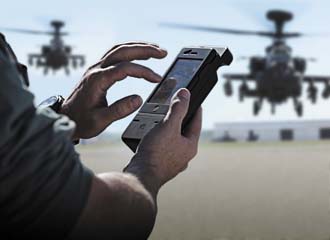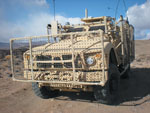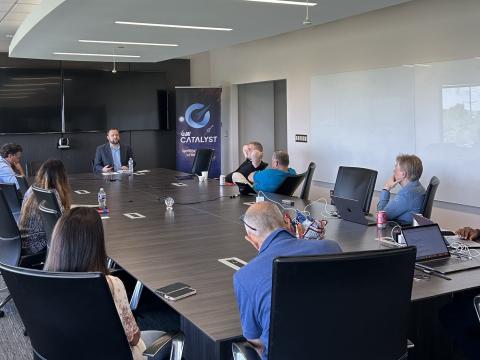Companies Invest in Tomorrow
 |
MONAX is one of Lockheed Martin Corporation’s latest innovations. Based on mobile network access, the MONAX Lynx handset transforms a smart phone into a tactical communications device connected through a persistent, dedicated, secure broadband network. |
In the real world, predicting the military’s requirements is not the work of soothsayers. Instead, it requires traditional and nontraditional defense contractors alike to keep their eyes wide open and their ears to the ground. If they plan to sell a solution to one or all of the armed services in the coming years, they had better be paying close attention today to technical gaps as well as wish lists. And although companies going after military and government business are similar in many ways, their approaches to garner that next big contract are often very different.
For General Dynamics C4 Systems,
EICs address what Gen. Palmer believes is one of the biggest obstacles to placing the best solutions into warfighters’ hands quickly. In the current acquisition processes, the services and agencies describe in great detail their requirements to contractors but are unaware of the art of the possible, Gen. Palmer explains. Instead, the EICs’ more than 140 members make it their business not only to understand the end users’ needs but also to look at available solutions and then build the best possible capability based on technology that exists.
“I like Henry Ford’s quote: ‘If I gave the customer what he asked for, I would have given him a faster horse.’ It [the U.S. Defense Department] writes these horrendous requirement documents that take years to write asking for a faster horse. And industry, if you’re working on a program, spends a lot of time writing ‘I’ll give you a faster horse because I can’t tell you about the car because you didn’t ask for it.’ We just go build the car. What we want to say is ‘I’ll build a faster horse, but I have a car that will meet your needs better,’” the general shares.
The development work does not take place in a vacuum. Gen. Palmer emphasizes that it is a collaborative effort, because the needs involve items General Dynamics does not produce. The centers’ annual research and development budget is in the range of $26 billion, with contributions from the various institutions that are part of the Edge.
In addition, the design process is not sequential, but rather visionary. It involves interaction among end users, customers and Edge members. This approach, plus the dollars to back it up, enables solutions to be created in days and weeks rather than months and years, Gen. Palmer notes.
One example of how Edge members have enhanced a capability is Boomerang. The technology was developed in 2006 to identify the position of a sniper. However, in its original form, the location data only could be seen in vehicles. Working with BBN Technologies, now a wholly owned subsidiary of Raytheon Company, the Edge integrated Boomerang into the Land Warrior program, and within approximately six weeks it was in the hands of warfighters. “We have set up a construct for competition, but really, we are bringing a bunch of capabilities together in the concept of rapid teaming,” Gen. Palmer says.
As does General Dynamics, QinetiQ North America,
Dr. J.D. Crouch II, president, technology solutions group, QinetiQ North America, calls the company’s approach “directed research and development.” First, it forms an intimate relationship with its customers so that its personnel understand the needs. Second, if they already exist, it provides the solutions to their customers. Third, if the QinetiQ team sees a “screaming need” for a solution that does not exist, the company invests its IR&D resources to find a solution.
The company also improves current products in the same way General Dynamics’ Edge enhanced the Boomerang solution. Because QinetiQ does not produce platforms, it develops relationships with companies that manufacture them.
For example, a product that defeats attacks from rocket-propelled grenades (RPGs) was created and deployed on the U.S. Army’s military all-terrain vehicles, which the Oshkosh Corporation manufactures. Although effective, the size and weight of the original anti-RPG equipment limited its use. Crouch explains that the QinetiQ team examined the problem and, looking at its own research as well as Defense Advanced Research Projects Agency (DARPA) work, created Q-Net, which is equally as secure as the original product. Working with the Army’s Rapid Equipping Force, the solution was fielded in less than a year, and warfighters are using it in
“A company must be able to do that quick turnaround. If you want that business, you have to be ready. If it had been a nonwartime requirement, it may not have proceeded that quickly,” Crouch notes.
In light of looming defense budget cuts, companies must view their IR&D investments with an eye toward incremental changes of established platforms, he states. Know the end users well enough to keep the lines of communication open, as well as the incremental changes that can be made to meet the users’ needs, Crouch adds.
 |
The Q-Net system, developed by QinetiQ North America and the Defense Advanced Research Projects Agency, uses a net design to defeat rocket-propelled grenades. |
None of this research is directed specifically at government customers, or in response to an RFP, a request for information or even with the government in mind, Shepherd says. However, the more than 900 research scientists at the institute, all with doctorates in various fields, work in broad areas that touch on advanced uses of technology in communications, collaboration, advanced networking, gaming and security, he notes. Interestingly enough, many of the experts do not examine technology itself but rather the people who are likely to use it. For example, among these researchers are social scientists and cultural anthropologists.
Although not focused solely on Defense Department customers, Microsoft certainly is heading into areas such as quantum computing, advanced computation and nanotechnology. Shepherd points out that the company’s track record for defining commercial consumer uses for software has been good for the department as well. In addition, cloud computing and semantic Web capabilities are gaining interest in the commercial sector and will certainly benefit the armed services, which must assess increasing amounts of data from a plethora of sensors.
Military leaders who visited Microsoft’s
“The Defense Department and government representatives were astonished and eager to see where it [Kinect] would fit into their business. They were talking about training, education and eventually office productivity,” Shepherd relates.
Although the company does not consider the military its target customer, institute personnel have been involved with DARPA and the Defense Science Board over the years. This work gives the experts the opportunity to “brush up against” these particular consumers to get a feel for what their needs could be five to 10 years from now. For example, the company is making “enormous investments” in quantum computing research and is always happy to talk to government representatives about its implications, he says.
Shepherd proudly states that the company offers one of the largest open-source research information websites online. Everyone—from a single consumer to advanced scientists—is invited to view the information and even download software to explore.
Seen more as a traditional defense contractor, Northrop Grumman Corporation continues to make the most of its IR&D decisions based on its overall business objectives and strategies despite the recession. Dr. Robert Brammer, chief technology officer for Northrop Grumman’s Information Systems division,
The council looks at technologies from a customer’s point of view to decide where to invest its IR&D funding. This method clarifies which solutions are likely to be useful to many organizations rather than just a few. It also helps determine which platforms and resources would be needed for various projects.
Designing a strategy is part of Northrop Grumman’s annual business planning process, but the strategy is reviewed quarterly. At these reviews, additional business opportunities are discussed, and the company determines the return on its IR&D investment, Brammer says.
This interactive process—among the company’s divisions, its customers and even universities—enables Northrop Grumman to take advantage of many levels of business opportunities, he adds. For example, innovations still in the idea stage—the equivalent of technology readiness levels (TRLs) 1 and 2—are being developed at the universities, and the company supports this research with funding. Concurrently, the company’s researchers focus on technical solutions that would be considered more in the TRL mid-range, Brammer explains.
One of the company’s IR&D long-term investment success stories is the Battlefield Airborne Communications Node (BACN). Northrop Grumman recognized the need for this capability and began creating it, but it took five years before the first sale to the U.S. Air Force occurred. BACN links legacy communication systems, which addresses interoperability problems, and was deployed to the battlefield in late 2010. “Ultimately, it was mature enough to provide the connection,” he shares.
Brammer believes that in some cases the reason an advanced technology fails is that it simply was introduced into the marketplace too soon for clients to adopt it—they do not see the value in it. In some cases, the customers want the product but do not have the resources to deploy it. While admitting that the company has invested IR&D funds into some projects it wishes it had not, overall Northrop Grumman mitigates risks by keeping in constant communication with its customers.
Clients are the key to Lockheed Martin Corporation’s IR&D investment decisions as well. According to Macy Summers, vice president for the strategic planning, innovation group, Lockheed Martin Corporation,
In his view, customers in general follow rational economic behavior when making decisions about technology purchases: If one solution costs 20 percent less than another, buyers will choose the better value. Observing clients’ behaviors is more important than listening to customers, he notes. As does Gen. Palmer, Summers believes in automobile mogul Ford’s quote about clients asking for a faster horse because they are unaware of the newest invention in transportation: the car.
Members of Lockheed Martin’s innovation group also look for what Summers calls “significant points of pain” when deciding how to spend IR&D resources. While all users will put up with some inconveniences or default to jerry-rigged solutions that already exist rather than buy an integrated one, they all reach a point where these are not acceptable. “What indicates that they have reached the threshold of pain to spend money? When a customer is bolting together products because the full solution doesn’t exist, then you know you could give them the total product,” he notes.
The military already has reached its “threshold of pain” while preparing for deployments, Summers asserts. Prior to shipping out, many warfighters head to the nearest Best Buy store to purchase what they know they will need to be able to communicate in the war zones. These items generally are inexpensive, so warfighters discard them when they no longer work. The problem with this approach, Summers points out, is that these products do not include customer or product support services, something the Defense Department prefers.
Once innovation group members have identified a gap, they ask themselves a number of questions prior to moving forward: How does this product fit with Lockheed Martin’s culture? How does it fit with what the company does well? What can the company create itself, and when must it look for partners to accomplish a goal? Who is the customer—a combatant command or an acquisition organization? When applicable, how successful will it be commercially? What about the chances of success of sales in general? Do purchasing vehicles such as the General Services Administration schedules exist so a product can be listed and sold through them?
“It’s not as simple as hunting for an RFP and getting together a proposal. [Investing in] IR&D is riskier, and the win rate is lower. But if you spend a lot more time on the front end [of the research process], if you look at the customer’s need, you know what your ‘cut rate’ is and you won’t build more,” Summers shares. Often, Lockheed Martin looks into markets where it does not have a presence but are ripe for a disruptive technology, he adds.
“The most critical thing is that you can’t jump into the technology first. If you go after that ‘shiny rock,’ it may be a great technology, but it’s not what the customers need or what the market is ready for. You have to be careful,” Summers offers.
Despite these warnings, Summers jumps at the chance to express his optimism in IR&D. “The culture has to be different. We have to tolerate more failures. We have to do our homework upfront. Failures don’t define you,” he states.
WEB RESOURCES
Microsoft Corporation Research: http://research.microsoft.com
Lockheed Martin Information Systems and Global Solutions: www.lockheedmartin.com/isgs
Northrop Grumman Information Systems: www.is.northropgrumman.com
General Dynamics C4 Systems: www.gdc4s.com
QinetiQ North



Comments